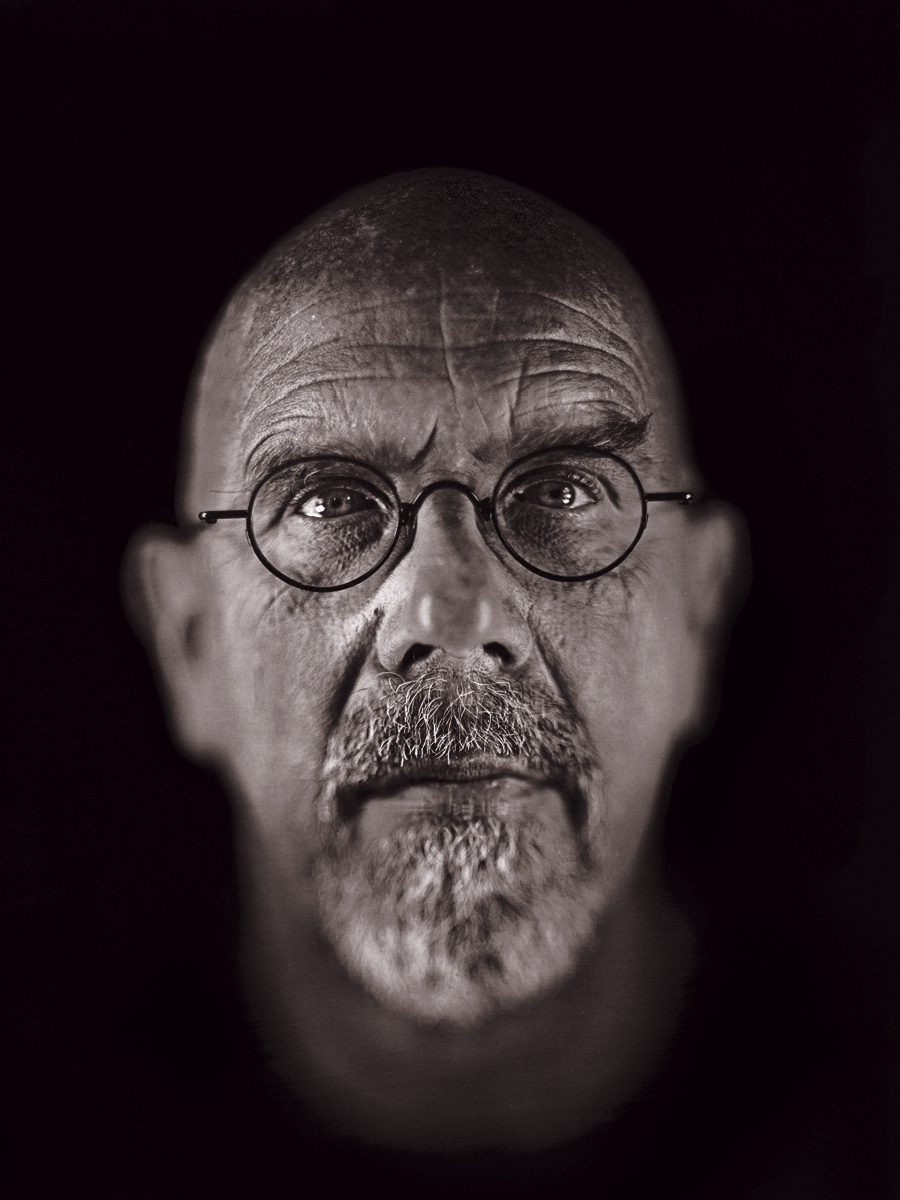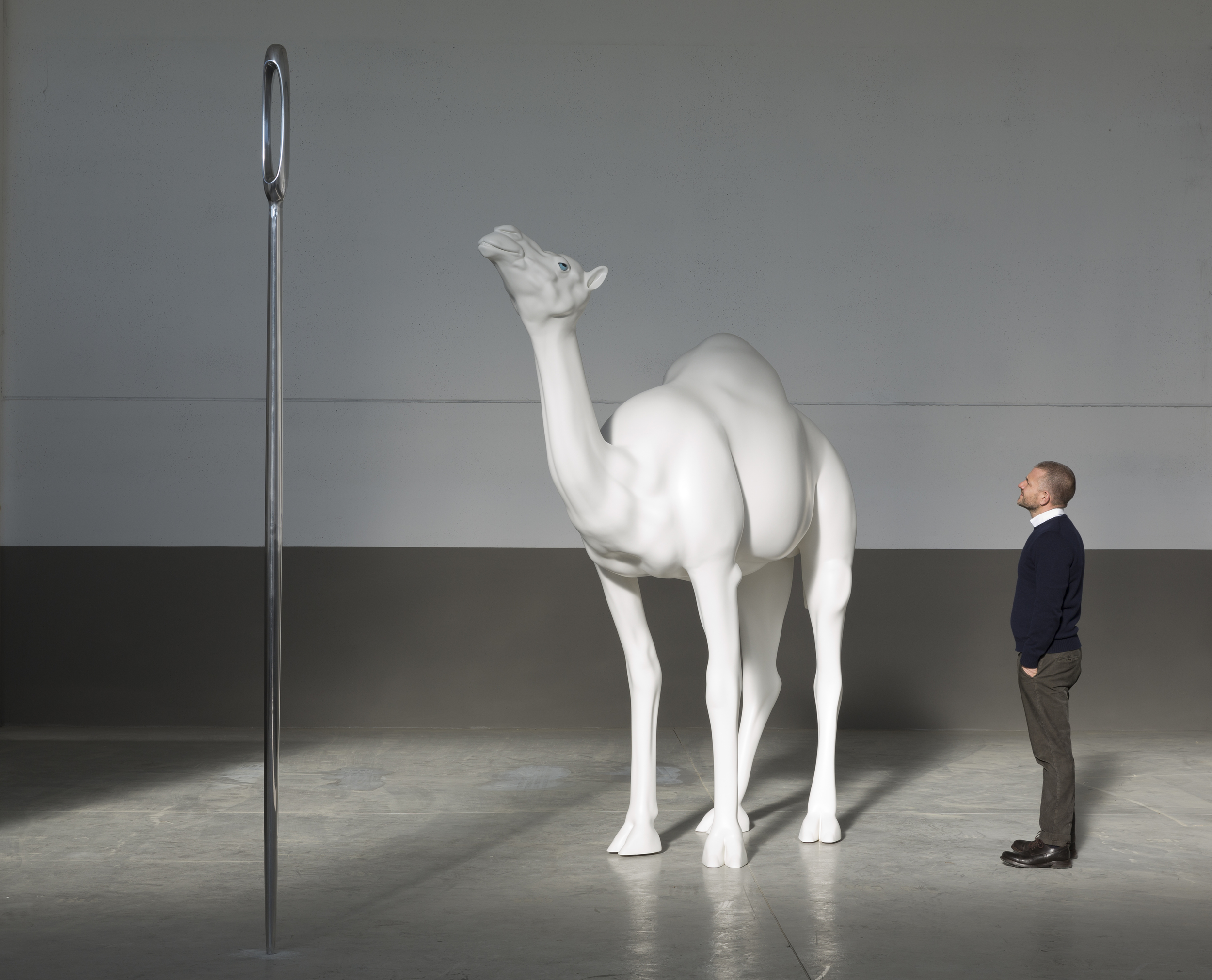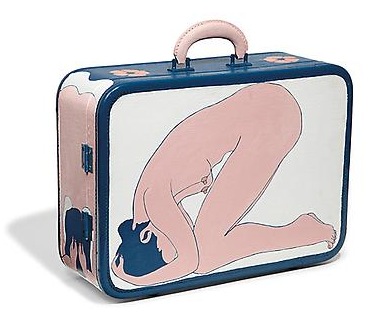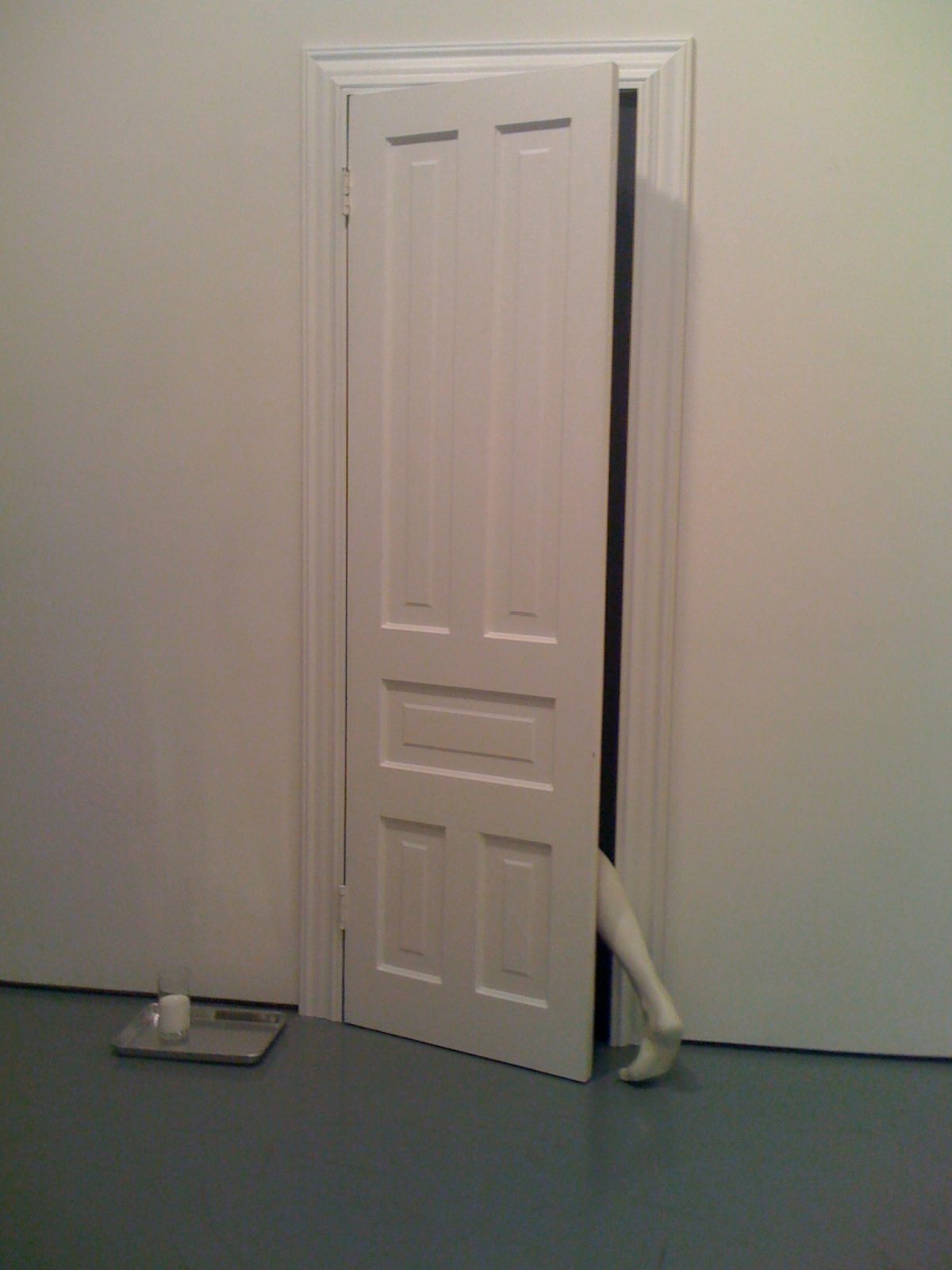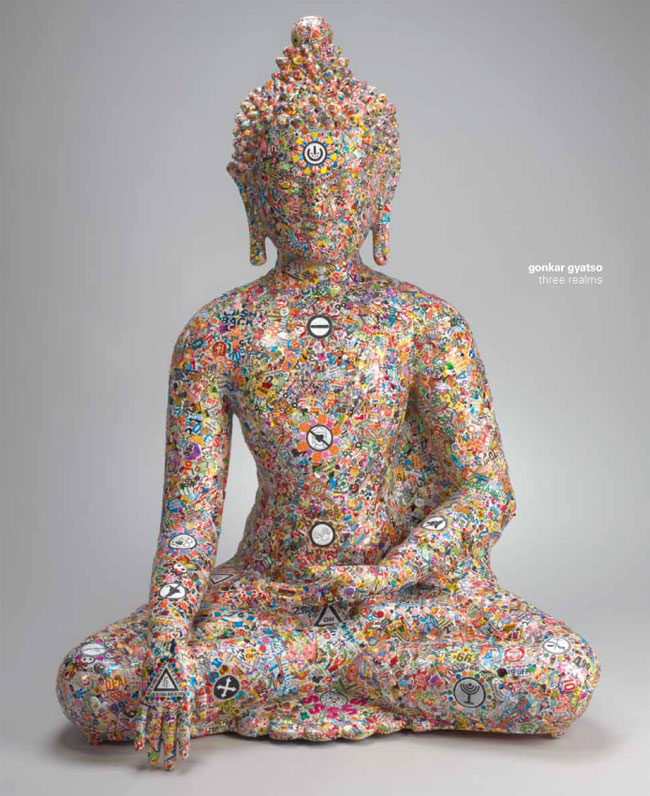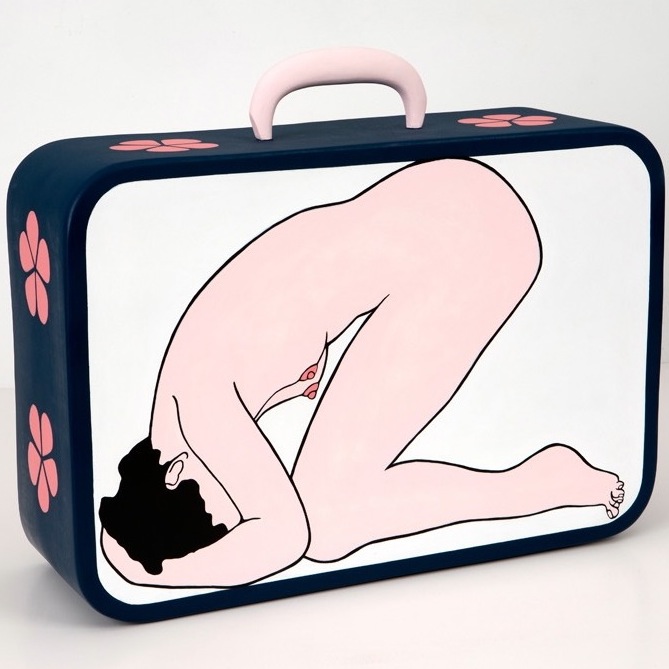The companion exhibition to A Couple of Ways of Doing Something, produced by Beyer Projects in 2006, was organized by Aperture and opens next at the Tarble Art Center on October 26th, 2013.
"As reflected in the title, A Couple of Ways of Doing Something is made up of portraits of some of Chuck Close's artist friends, represented in different media with photographs by Close — daguerreotypes, tapestries, pigment prints, and photogravures — and with lyrical praise poems by Bob Holman. Lyle Rexer observed that Close regularly exhibits work in different media together so that viewers can experience the radical differences inherent among them and the various ways of seeing they engender. Says Close, "People think that if you have a photographic image, there is pretty much only one thing you can do with it, that because of its iconography, it is fixed. But changing the medium, the method of mark-making, and the scale transforms the experience of that image into something new.” (Source: Tarble Art Center)
News
John Baldessari: Camel (Albino) Contemplating Needle (Large)
John Baldessari's newest sculpture is Camel (Albino) Contemplating Needle (Large)
Simryn Gill: Australian Pavilion at the 2013 Venice Biennale
Click the image for video
Beyer Projects is pleased to release Insomnia by Simryn Gill. This artist edition was published to coincide with the opening of Gill's Australian Pavilion at the 2013 Venice Biennale. The above video, narrated by curator Catherine de Zegher, captures the look and feel of the artist's sublime installation.
A Brief History of John Baldessari
Click the image for video
LACMA produced this fantastic video to honor John Baldessari and Clint Eastwood at their 2011 Art + Film gala. At 400,000+ views and climbing, this short has to be one of the most entertaining artist profiles we've ever seen. An Ear Trumpet poster is visible behind Baldessari's desk, beginning at 0'11".
Tavares Strachan's Polar Eclipse at the Venice Biennale on Vernissage TV
Click the image for video
Beyer Projects is pleased to announce our partnership with Tavares Strachan in production of work for the Bahamas Pavilion, 2013 Venice Biennale. Vernissage TV interviewed Strachan during final installation.
"The artist Tavares Strachan represents The Bahamas in the nation's inaugural pavilion at the 55th International Art Exhibition -- La Biennale di Venezia 2013. Curated by Jean Crutchfield and Robert Hobbs, Tavares Strachan conceived an immersive installation that includes different media such as neon signs, video, sculpture, and painting, and surrounds the viewer by documentation of a reenactment of a historic narrative: the 1909 polar expedition of Robert Peary and Matthew Alexander Henson." (Source: Vernissage TV)
John Wesley in The Pop Object: The Still Life Tradition in Pop Art
Beyer Projects worked with John Wesley to create Islamic in 2009. The work is based on a suitcase the artist painted in 1964, and thought to be lost or destroyed before resurfacing at a Connecticut auction house in 2011. The original suitcase (pictured, at left) is now on view in Acquavella Gallery's superb exhibition The Pop Object: The Still Life Tradition in Pop Art , curated by art historian John Wilmerding:
"Still life also has long been treated as a minor preoccupation for artists, yet has turned out to be the occasion for some of Pop’s most innovative and witty expressions,” said Wilmerding... "Though Pop artists did not consider themselves as being a part of a unified movement, the still life object has been of shared interest to both canonical Pop artists and lesser-known artists. Two major innovative ideas will be explored in the exhibition: the expansion of still life beyond painting into multidimensional sculptural forms, and the presentation of a variety of new media as modes of expression."
Julião Sarmento's White Nights Retrospective at the Fundação de Serralves
Beyer Projects congratulates Julião Sarmento on his White Nights retrospective exhibition at the Fundação de Serralves in Porto, Portugal. The exhibition includes Sarmento's sculpture, White Exit (pictured, at left), produced in partnership with Beyer Projects in 2011.
"On November 23, the Serralves Museum of Contemporary Art will open the world’s largest-ever retrospective exhibition of the work of Julião Sarmento (Lisbon, 1948). Over the last four decades, Julião Sarmento's work has achieved widespread international circulation, making him one of Portugal’s best-known contemporary artists...
Sarmento's work explores themes of eroticism and sexuality, and questions concepts such as desire, absence, time and language, using different techniques - such as painting, drawing, sculpture, installation, film, photography and performance..." (Source: Fundação de Serralves)
The exhibition runs through March 3, 2013.
John Baldessari Brain/Cloud Mural in La Jolla, CA
Murals of La Jolla installed John Baldessari's Brain/Cloud (with Seascape and Palm Tree) in 2011. The work references Brain/Cloud (2007), from the artists's Pure Beauty retrospective exhibition. When in La Jolla, enjoy the view over lunch at Georges at the Cove.
Kay Rosen: Sweet Jesus
Beyer Projects is pleased to announce Sweet Jesus by Kay Rosen. The work is currently included in the exhibition Kay Rosen: Wide and Deep at Sikkema & Jenkins Co., New York.
The artist’s first project with us is a wall-mounted light box produced in edition of 6. This intimate work is connected to a 2011 series of drawings of phrases depicted as overlapping letters, which were made according to a pair of predetermined constraints: each phrase must begin and end with the same letter, and must bear a formal or stylistic correlation to its meaning. This visual symmetry is thrown into sharp relief by the brilliantly backlit, overlain letters of Sweet Jesus, which can be seen all at once, as a bright abstraction, or identified individually. As a three-dimensional object, the work dramatizes what has been an implicit theme of Rosen’s art of the past four decades: the idea that words, far from being neutral instruments of communication, can possess an obdurate physicality and their own tangible, even sculptural, qualities. In her presentation of the title phrase as translucent, Rosen demonstrates—seemingly paradoxically—how language can resist the transparency often ascribed to it.
Indeed, Rosen’s work in a variety of mediums (painting, drawing, editions, and installations) has cleverly shown how words’ physical qualities—typeface, color, spacing, scale, positioning—can alter legibility and, in turn, affect meaning. She favors those instances of language that foreground linguistic materiality and confound the processes of seeing and reading, such as misspellings, homonyms, homophones, rhymes, puns, palindromes, and double-entendres. This use of word as image, and the rule-based methods according to which this work was created, aligns Rosen with a text-based Conceptualist heritage that includes Lawrence Weiner and Ed Ruscha, but other ties are also evident. Her chosen words and phrases, like those of her contemporary Jenny Holzer, often have pointed political implications, while on a purely formal register, the stacked letterforms of Sweet Jesus call up Jasper Johns’s overlapping numbers and alphabets. And if the work’s means and devotional size evoke yet another tradition—a history of religious art that encompasses illuminated manuscripts and stained glass windows—the link is hardly unequivocal. “Sweet Jesus” is, after all, often used as an expression of surprise or stupefaction.
Gonkar Gyatso: Three Realms in Brisbane, Australia
Beyer Projects congratulates Gonkar Gyatso on his Three Realms exhibition, organized by the Griffith University Art Gallery and exhibition partners The University of Queensland Art Museum and the Institute of Modern Art from August 2011 to April 2012. The exhibition includes sculpture produced by Beyer Projects in collaboration with the artist, and is accompanied by the most extensive published monograph on the artist to date.
"For many years Gonkar Gyatso has encrusted traditional Buddhist iconography with pop cultural referents to explore issues of identity, globalisation, hybridity, and consumerism. Significant new directions in his practice signal an opportune moment to consider one of world art’s rising contemporary art stars…
Much of Gyatso's work charts shifts in identity in relation to continual migration. It has moved through traditional Chinese brush techniques and Buddhist iconography to high-density pop collages of colourful stickers and cut-out text, playing on but subverting typecast notions of pop art and Tibetan culture while reflecting on the popularity of Buddhism in the West. In combining references to traditional Tibetan life with references to a global mass-media culture that threatens to supplant and extinguish it, Gyatso creates a volatile, ambivalent mix…" (Source: Institute of Modern Art)
John Baldessari Giacometti Variations at the Fondazione Prada, Milano
Click the image for video
For John Baldessari's collaboration with curator Germano Celant and the Fondazione Prada, Milano, the artist conceived the Giacometti Variations. The work's monumental scale fulfills a longstanding wish to “do tall paintings and sculptures." Though fashion may seem to be new territory for the artist, much of Baldessari’s work in photography of the past several decades manifests a knowing engagement with the psychology of appearance and style. He covers the human faces in his appropriated photographs with colored discs, he says, because they convey too much; when faces are concealed, viewers are forced to pay attention to surroundings, pose, and body language. Clothing is yet another visual cue, and it is explored here, in Baldessari’s trademark vibrant hues, to exaggerated and often humorous or dramatic ends. The sculptures are almost identical, but the addition of a few sartorial touches—from the comedy of a massive clown shoe, to the Surrealist flourish of floor-length golden braids and a ladder, to the opulence of a fuchsia bow in duchess satin—renders each unique.
The above Italian language video offers a walkthrough of the installation.
John Baldessari: Pure Beauty
Beyer Projects congratulates John Baldessari on the opening of his Pure Beauty retrospective at the Tate Modern in London. The above Vernissage TV video provides a walkthrough of the exhibition, ending with great footage of the Brain/Cloud at 5m00s.
John Baldessari: Ear Sofa Nose Sconses With Flowers (In Stage Setting)
John Baldessari's Ear Sofa and Nose Sconses will be part of the artist's first ever tableau-vivant, opening tomorrow in London at Sprüth Magers.
Julian Opie: Animals, Buildings, Cars, and People
Beyer Projects worked with Julian Opie on his 2004 Public Art Fund installation in lower Manhattan's City Hall Park. On the occasion of the exhibition, we produced four full-scale car sculptures and a smaller series, entitled Garage?
"Animals, Buildings, Cars, and People is Julian Opie’s first U.S. sculpture survey, featuring fourteen works from nine different series made between 1997 and the present. Succinct, colorful, and seductive, Opie’s iconic imagery portrays the familiar physical world, from fashion models to farm animals, from skyscrapers to village churches. His work has been seen all over the world, in museums, galleries, corporate atriums, shops, airports, and even in a parking garage and a hospital cafeteria. He has rarely shown his sculptures in the United States, though his singular graphic sensibility, as seen on his album cover design for The Best of Blur, is familiar to many..." (Source: Public Art Fund)
John Wesley: Islamic
Beyer Projects is pleased to announce Islamic, a painted bronze edition by John Wesley. The project, an edition of 6, is based on a 1964 work entitled Islamic that has since been destroyed. Wesley’s paintings, as many scholars have noted, employ styles associated with the Pop and Surrealist movements and yet defy categorization as either. His works are deceptively simple: an economy of line, an insistently flat, often distant execution with an interest in repetition, and a restricted palette are defining features. And yet this apparent simplicity belies the presence of an extraordinary eye for composition, a measured gesture in which no line is extraneous, and a perceptive, curious, and unabashedly erotic mind for which the unknown and the imaginary are powerful provocations.
The nudes in Wesley’s works are drawn from existing media; his method involves tracing those found forms and then grafting them onto the canvas or object and enlarging them exponentially via a mathematical formula.
David Rabinowitch at Fredericks & Freiser
David Rabinowitch's new work, Gravitational Vehicle VIII for Kepler and Euclid, we be included in a group exhibition at Fredericks & Freiser gallery, opening tomorrow.
Rabinowitch traces the series back to an early childhood interest in the work of the surrealist painter and sculptor Giorgio de Chirico and the way in which de Chirico, “combined ordinary historical conditions of the world with modern constructivism.” These two concerns — historical conditions and modern constructivism (a concept that the artist broadens to include the work of Cezanne) — inform much of Rabinowitch’s body of work.
The title of the series offers rich insight into some of the central ideas that inform the project. The name makes obvious reference to the natural phenomenon of gravity, although Rabinowitch is careful to clarify that he is neither a philosopher nor a theoretician. His interest is motivated by the intellectual and cultural value of these scientific and mathematical discoveries. Additionally, most works in the series are subtitled with the name of one or two contributors to modern scientific and mathematical discovery. The ascriptions serve as memorials to the human beings whose work contributed greatly to Western cultural development.
While discussing the Gravitational Vehicles series, the artist offered the opinion that “if a work doesn't contain within it an essential element of play, it is no good.” Perhaps one can then consider an encounter with a Gravitational Vehicle as an opportunity for playful exploration, activating creativity and the imagination. By presenting the viewer an opportunity in which a preexisting awareness of Western science is not requisite but simply an additional element for interpretation, Gravitational Vehicle VIII For Kepler & Euclid allows us to contemplate form and content while extrapolating an evolutionary thread's aesthetic and cultural legacy.
The Fredericks & Freiser exhibition will also include Beyer Projects collaborations with Anish Kapoor and Rachel Whiteread.
Richard Tuttle in Design ≠ Art, Cooper-Hewitt National Design Museum
Richard Tuttle's Masculin, produced by Beyer Projects, was included in the groundbreaking 2004 exhibition Design ≠ Art at the Cooper-Hewitt National Design Museum.
"Curated by Barbara Bloemink, Curatorial Director at Cooper-Hewitt, and independent curator Joseph Cunningham, the exhibition is the first by an American museum to feature functional objects by artists such as Donald Judd, Richard Tuttle, Scott Burton, Sol LeWitt, James Turrell and Rachel Whiteread, among others...
Richard Tuttle recently observed that the creation of design objects by artists is “one of the great secrets of the late twentieth century, and long overdue for a museum exhibition.” His design objects, like his art, are syntheses of Minimalism and post-Minimalism. With whimsical originality, Tuttle juxtaposes unusual materials, manipulates proportions and organizes space in new ways. The exhibition will feature a number of Tuttle’s furniture and design objects..." (Source: Cooper-Hewitt National Design Museum)

